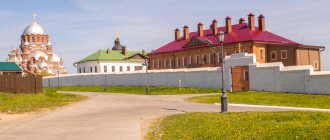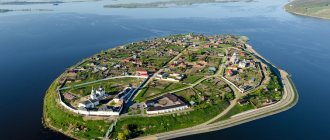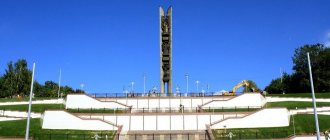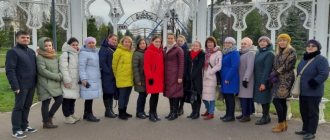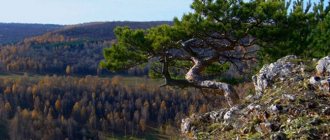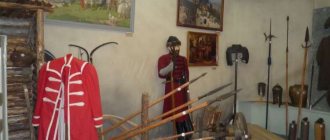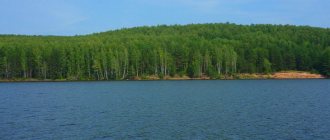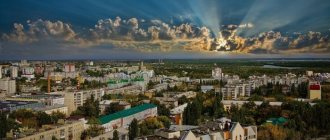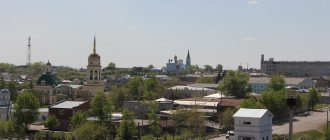If you arrived in Kazan on business or on a tourist trip and have a free day, do not miss the opportunity to visit the wonderful island town of Sviyazhsk.
The distance from Kazan to the island is only 30 km. You can get here by land and water. It's faster by land, more interesting by water.
Motor ships depart from the Kazan river station. First they walk along the Volga, and then along the Sviyaga River.
Let's go on an exciting journey too. Let's take seats on the upper deck to delight the eye with wonderful scenery.
Along the way, we see picturesque villages and holiday villages, snow-white churches with golden domes, colorful islands and islets.
And now, around the bend of the Sviyaga River, a miracle city appears.
Island town of Sviyazhsk.
We, the residents of Sviyazhsk, are incredibly lucky. If in big cities people go to museums, then we live in a museum. Sviyazhsk is a historical, architectural and art museum-reserve. And to the question: “What to see in 1 day in Sviyazhsk?” - the answer follows: “That’s it!”
It is impossible to selectively see the sights; they are here at every step.
The fortress is ancient, founded during the reign of Tsar Ivan the Terrible. It was built as an outpost for the Tsar's troops before the conquest of Kazan. And throughout the history of its existence, the city has preserved many unique architectural structures.
Actually, Sviyazhsk is a village; only 250 people live in it. But we respectfully call it a city, as the founders of the fortress called it in ancient times.
The ship moored to the pier. And in front of us is the building of the river port. This is a remake, but it completely reproduces the architecture of the ancient building. Here, in addition to ticket offices for land and water transport, the information center is based. The tourist who travels independently will find it useful.
River station building.
And we begin our excursion.
Museum "Tatar Slobodka"
From the boat we will go up the path to a unique repository - the museum of the archaeological tree “Tatarskaya Slobodka”. On the territory of Sviyazhsk it is impossible to disturb the natural landscape with modern buildings, so the museum was disguised as a hill.
In the 16th - 18th centuries. there was a Tatar settlement in this place. The remains of wooden buildings were left where they were discovered. And around them in glass cases there is an exhibition: tools and ancient weapons, kitchen utensils, leather shoes and even toys. All this was found at the excavation site.
The highlight of the museum is a huge animated panel. The life of a 17th-century settlement is reproduced in animation mode.
Believe it or not, there are 450 different characters involved in 100 everyday scenes! The animation characters saw logs, build, fish, wash clothes, put out fires, and simply go about their business.
This museum is a must visit!
Chapel of Constantine and Helena
Meanwhile, we are going up Rozhdestvenskaya Street, turning onto the street. Konstantinovskaya and approach the chapel of the Holy Equal-to-the-Apostles Tsar Constantine and his mother Helen.
The wooden church erected under Ivan the Terrible has not survived. We can see a stone temple from the late 17th century. The church is white stone, with Baroque elements in architecture. It looks very elegant.
Chapel of Constantine and Helena.
Civil War Museum
Opposite the church is a nice mansion with a mezzanine and white columns in the spirit of noble estates of the 19th century. This is the Civil War Museum, which is also called the Trotsky Museum. Lev Davidovich led the operation to capture Kazan, and the front headquarters was in Sviyazhsk. Therefore, part of the exhibition is dedicated to the People's Commissar.
The interior of Trotsky's office has been reproduced, where his plaster figure can be seen behind the desk.
The other part of the exhibition tells directly about the events of the Civil War.
From the Trotsky Museum on the street. Moskovskaya we go up to a modest memorial - the wall of the Communards in honor of the fallen Red Army communists. From here we turn onto Uspenskaya Street, which leads straight to the Sviyazhsk History Museum.
Monuments and sculptures of Sviyazhsk
In such a historical center as Sviyazhsk, every little thing is connected with the events of the past. Monuments and sculptures are small, sometimes unnoticeable details, but even they are endowed with a special meaning and preserve the memory of past centuries.
Boat of Paul the First
- GPS coordinates: 55.773759, 48.668211.
The monument is located not far from Zarechny railway station. This is an exact copy of Pavel Petrovich’s wooden boat, on which he traveled from Sviyazhsk to Kazan. The vessel is equipped with two dozen pairs of oars, and on the bow there is a figure of an eagle rapidly flying forward. The boat was built according to drawings and drawings preserved in maritime books of the 18th century.
Cannon "Devka's head"
- Address: Uspenskaya street, 22.
At the entrance to the Museum of the History of Sviyazhsk there is an interesting monument - the “Devka’s Head” cannon, so named because of the bas-relief of the Gorgon Medusa that decorated the cannon.
Modern Sviyazhsk is a peaceful town, but in the 16th century it served as a fortress, and defensive weapons were everywhere here. The "Devka's Head" cannons were especially important, since they were used to protect the main gates of the city. The monument to this weapon is an exact copy of a 16th century cannon. It was created according to ancient drawings discovered in manuscripts from the era of Ivan the Terrible.
Today “Devka’s Head” is one of the exhibits of the historical museum and is a symbol of the ancient fortress city of Sviyazhsk.
Wall of the Communards
- Address: Rozhdestvenskaya Square.
The Wall of the Communards is a granite stele set against the background of a white stone wall. This monument marks the place where Red Guards were executed by firing squad in August 1918. The memorial is located on Rozhdestvenskaya Square, with red carnations planted at its foot.
Monument to the Victims of Political Repression
- Address: Uspenskaya st., 4.
After the end of the Great Patriotic War, Sviyazhsk became a place of mass exile, and Gulag camps settled on its territory, where political prisoners were kept, as well as war veterans who were injured in battle.
The monument in memory of the victims of Stalin's repressions appeared in 2011. It is made in the form of a stone wall with a bronze high relief: an elderly prisoner stretches his hand through the bars, releasing a bird. At the bottom of the high relief there is a memorial inscription in two languages (Russian and Tatar), as well as three lines of barbed wire.
Monument to St. Sergius
- Address: Uspenskaya street, 1.
The stone statue of Sergius of Radonezh was created in 1997, but soon mysteriously disappeared. Several years later, during restoration work, it was found buried in the ground near the walls of the Assumption Cathedral. In 2021, the statue was restored and placed in its original location.
On the occasion of the opening of the monument, the abbot of the monastery, Abbot Simeon, gave an interview in which he noted that the return of the sculpture is an important event in the life of the Sviyazhsk monastery, since it is an important detail of its architectural ensemble and a tribute to the memory of St. Sergius, the spiritual collector of the Russian people.
Don't miss reviews of other cities of Tatarstan - Bolgar, Bugulma, Zelenodolsk, Almetyevsk, Yelabuga, Kazan, Chistopol and Naberezhnye Chelny
Sviyazhsk is a city in which everything breathes history and secrets of the past. To visit here means to plunge into the Middle Ages. Such a trip will give unforgettable emotions and impressions and will be interesting to travelers of any age.
Museum of the History of Sviyazhsk
The museum's exposition is housed in 4 buildings of the former prison, built in the first half of the 19th century. The exhibits tell about the history of Sviyazhsk since its foundation.
There are many archaeological finds, archival documents and rare photographs. A collection of tiles, jewelry, ancient coins, and children's toys is presented.
The models reproduce scenes from the life of Sviyazhsk residents: the work of a flour miller and blacksmith, the work of laundresses, construction and military exercises.
The work of a flour mill is not easy.
The exhibition “Sviyazhsk Prisons” introduces visitors to the history of correctional institutions on the island.
Cultural and natural landscape of Sviyazhsk.
Comprehensive restoration and reconstruction work in the fortress and cathedrals has been carried out in Sviyazhsk since 2010 under the “Renaissance” program; at the same time, the city’s housing stock is being updated, new premises are being built for cultural institutions, hotels, etc.
In 2021, an application was submitted for inclusion in the list of sites under the protection of UNESCO, the Assumption Monastery and the Trinity Church.
Mother of God Assumption Monastery
After visiting the museum, we reach Assumption Square and enter the territory of the Mother of God Assumption Monastery. The year of its foundation is 1555. At one time it was the richest monastery.
There are several places of worship here:
- the snow-white gateway Church of the Ascension of the Lord above the main gate of the monastery;
- St. Nicholas refectory church-bell tower;
- small church of St. Herman of Kazan and Mitrofan of Voronezh;
- single-domed Assumption Cathedral.
The cathedral is very elegant. It was immediately built of stone (1561). After repeated reconstructions, it acquired Baroque features. The uniqueness of the temple is that frescoes from the 16th century have been preserved inside. The gilded 5-tier iconostasis is another asset of the cathedral.
Assumption Cathedral.
There are other buildings: the abbot's and fraternal buildings and the building of the monastery school.
What to see in Sviyazhsk in one day
An incredible number of tourist sites fit into the relatively small territory of Sviyazhsk. It’s impossible to get around them in 1 day, but visiting the “pearls” of the island-city can easily be done in 24 hours.
Sviyazhsk Mother of God Assumption Monastery
- Address: Uspenskaya st., 1.
The monastery was founded in 1555 by decree of Ivan IV the Terrible. The first rector of the monastery was Archimandrite German, who established here one of the first printing houses in Russia for printing service books and the Bible. Thanks to this, the monastery became the main spiritual and educational center of the Kazan diocese, which it remained until the 18th century.
In the middle of the 19th century, the monastery began to slowly decline. Income became less and less, and the monks began to leave the impoverished monastery.
In the 20th century, the monastery suffered several crushing blows. In August 1918, Red Army soldiers invaded its territory and brutally killed the rector, Bishop Ambrose, after which they plundered the churches. In 1923, a tornado broke out over Sviyazhsk, destroying part of the historical buildings.
The monastery stood in dilapidated condition for a long time. In 1994, some buildings were renovated and became a psychiatric clinic.
The revival of the cult complex took place in 1997. After large-scale reconstruction work, the monastery returned to its original appearance: temples, monastic cells, stone fences and monuments destroyed during robbery and hurricane were restored.
Today the Sviyazhsk Mother of God Assumption Monastery is a UNESCO World Heritage Site and is recognized as the main architectural and historical monument of the island city.
Museum of the History of Sviyazhsk
- Address: Uspenskaya street, 22.
The museum is located in four buildings of the state-owned complex, built in the first half of the 19th century. The museum's exhibitions are dedicated to the history of the island and its cultural heritage. The main exhibition occupies the central building. During the excursion, tourists travel to the origins of the provincial town of Sviyazhsk and learn about how its settlers lived in different eras.
It will be no less interesting to visit the “prison” building - a building in which the furnishings of a prison cell from the last century have been recreated down to the smallest detail, and a model hall where a detailed model of the island-city is presented. The miniature composition provides an opportunity to see what Sviyazhsk was like in the 19th century.
The peculiarity of the layout lies in the painstaking detailing. There are models of wooden churches, figurines of peasants, trees and bushes. The model is equipped with a backlight that simulates the change of time of day. With the onset of “night,” the lights come on in the tiny huts.
The museum is ideal for children. The interactive excursion will be interesting for children of any age, and upon completion they will be able to have fun in a children's playroom equipped especially for them.
The best on the site: Entertainment in Kazan for children
Rozhdestvenskaya Square
- Coordinates on the map: 55.772867, 48.662513.
Rozhdestvenskaya Square is one of the most popular vacation spots for city residents. It received its name in honor of the Church of the Nativity of the Blessed Virgin Mary, which was destroyed in the 1930s. Its ruins are located not far from here and are a local landmark.
Tourists are also attracted by the nearby restaurants and cafes, but the main “calling card” of this corner is the observation deck, which offers a beautiful view of the Volga.
Christmas Square is furnished with taste and comfort. For tourists to relax, paths are paved here, comfortable benches and lanterns are installed, thanks to which evening walks are possible. The picturesqueness of the square is added by well-groomed lawns and colorful flower beds. The area is kept clean and in perfect order.
Ethnographic complex "Horse yard"
Opposite the monastery is an interesting place. This is the ethnographic complex “Horse Yard”.
The history of the complex dates back to the 16th century, when the monastery acquired its own stable. The original structure was wooden. In the 18th century it is being rebuilt from stone.
The tourist complex consists of several craft workshops: pottery, leather, and blacksmithing. There are also stables, souvenir shops, and the Traktir restaurant. All buildings are connected to each other and form a closed courtyard. And in the center of it is a riding arena.
Horse yard.
Let's look into the workshops and take part in blacksmithing or pottery. At the national costume shop, we’ll dress up and take a memorable photo. And then we’ll ride some thoroughbred horses.
John the Baptist Convent
From the horse yard we go out onto Troitskaya Street, which leads us to the huge courtyard of the St. John the Baptist Sviyazhsk Convent. True, now this is the courtyard of the monastery, which we have already visited.
John the Baptist Monastery was founded in the 16th century. The original wooden buildings did not survive; they were destroyed by fire at the end of the 18th century. And then they began to erect stone structures.
There are several places of worship on the territory of the monastery:
- Trinity Church (1551) is the same age as the city. Assembled without a single nail. The only example of wooden architecture that was not destroyed by fire. The decoration of the shrine is a carved iconostasis.
Trinity wooden church.
- The stone church of St. Sergius of Radonezh (1604) is a single-domed temple with a low bell tower. The property of the church is a fresco, which is an enlarged copy of the Trinity icon by Andrei Rublev.
- Mourning Cathedral in the Byzantine style of the late 19th - early 20th centuries. The multi-domed church was erected in the name of the icon of the Mother of God “Joy of All Who Sorrow.” The height of the cathedral is 32 m, thanks to which it is clearly visible from afar.
Cathedral of Sorrows.
The interior decoration of the cathedral is very rich. It's a must visit.
Iconostasis of the cathedral.
- Single-domed chapel of the royal martyrs. The red brick church in neo-Byzantine style is located near the monastery fence.
We leave the shrine, walk along the white monastery wall and go out onto Rozhdestvenskaya Square.
Architecture of the ancient island-city
Sviyazhsk urban development combines modernity and antiquity. New buildings are adjacent to buildings of the 18th-19th centuries, which gives the city an extraordinary flavor.
River station building
- Address: Sviyaga River embankment.
The journey around Sviyazhsk begins from here - from the river station, the building of which was built in 2011, but its appearance resembles an old Russian tower of the 19th century. This is a small two-story house made of red brick.
Its unusual appearance is given by kokoshnik roofs with thin spiers and a weather vane over the central part of the building.
As for the facade, rectangular windows with triangular canopies and figured masonry add zest to it. There are lawns and clubs around the station, and behind it there is a view of the far bank of the Volga.
Women's gymnasium building
- Address: pl. Rozhdestvenskaya, 3.
The brick building in the Gothic style was erected at the beginning of the 20th century. Its pediment is decorated with lancet windows and stained glass roses - elements most often found in Catholic churches.
The women's gymnasium was a prestigious educational institution for girls from noble families. It was closed after the revolution, and in its place a regular secondary school was established, which still exists today.
Today the building is recognized as an architectural monument and plays a significant role in the appearance of modern Sviyazhsk.
House of merchant Kamenev
- Address: Rozhdestvenskaya Square, 2.
F.T. Kamenev was one of the richest merchants of Sviyazhsk. He owned factories, groceries and shipyards. It was he who owned the two-story estate, built at the end of the 19th century. Its first floor was made of brick and housed a grocery store. The second floor, built of wood, was occupied by the Kamenev family.
The estate was a wonderful example of Old Russian architecture. Its upper floor was decorated with pilasters, expressive platbands and wide cornices. All decorative elements were covered with fine handmade carvings, which gave the building the appearance of a princely mansion.
The Kamenevs lived in the estate until 1918. After the revolution, the Soviet government seized the estate from its rightful owner and turned it into a hostel. Gradually the house fell into disrepair. Without proper maintenance, it soon began to deteriorate and was eventually demolished.
In 2011, work began on restoring the monument to wooden architecture. The house was restored with the utmost precision. Old drawings and photographs were used in the reconstruction.
Today, in Kamenev’s house there is a hotel of the same name. The interior of the building is decorated in a retro style, so guests can feel the atmosphere of a merchant's mansion.
Old water tower
- Address: Rozhdestvensky Lane, 4/6.
The water tower was built at the end of the 19th century. - at the beginning of the 20th century. The tall, brick-built structure was in use until 1980.
After decommissioning, the tower came into the possession of a research institute, whose specialty is the study of old buildings for the purpose of restoration. The structure was restored using surviving drawings, records and photographs. Work on it was completed in 2014.
Today, on the ground floor of the Old Water Tower there is an exhibition center displaying the work of contemporary artists and craftsmen.
Architectural complex "Horse yard"
- Address: Uspenskaya st., 1A.
The horse yard has existed since the founding of the city. In the 16th century it consisted of wooden buildings. The log stables, arenas and forges served the inhabitants of the island for 200 years, after which they were demolished and new stone buildings stood in their place, which have survived to this day.
Today the Horse Yard is a popular historical and tourist center. Its guests can go on a horseback ride, look into the forge, where, just like in the good old days, hammers knock on an anvil and finished horseshoes cool down. You can also order a commemorative minted coin here. Also on the territory of the Horse Yard there are bread and honey shops, restaurants serving national cuisine, and souvenir shops.
Another interesting service is carriage excursions. Tourists sit in carriages drawn by graceful horses, and a guide-cab driver takes them to the most interesting places in Sviyazhsk.
Rozhdestvenskaya Square
It is surrounded by ancient stone houses, including the estate of the merchant Fyodor Kamenev (late 19th century). The house is rich, with carved window frames and a balcony parapet, with wooden lace under the roof slope. Merchants could afford a beautiful life. Now there is a hotel here.
House of merchant Kamenev.
At one time, the square was surrounded by 3 temples. A cross was installed on the site of the St. Sophia Church. And all that remains of the Cathedral of the Nativity of the Virgin Mary and the Church of the Annunciation are ruins.
The square has one special feature: it has unique acoustics. In the center there is an amazing spot. By standing on it and saying any word, you can hear a deep echo.
In addition, Rozhdestvenskaya Square is a good observation deck. From here you can enjoy a panoramic view of the town and a view of the river.
Excursions. Prices for museum tickets.
Most museums in the city operate as usual from 10 a.m. to 6 p.m. The cost of visiting, as a rule, does not exceed eighty rubles. Tourists also have the opportunity to purchase a single ticket to all museums in Sviyazhsk. Such a purchase is profitable because it saves up to twenty percent.
A visit to the attraction will be interesting for both adults and children. On the territory of the Horse Yard there is an opportunity to ride a horse. Children will also enjoy the cultural, stylized medieval town. Here you can compete in archery and try on real armor. On weekends, staged knightly battles and spectacular shows are held on the territory of the center.
You can have lunch at the art cafe “Fisherman’s Compound”. This place looks like an old fisherman's hut. It offers excellent views of the river. There is also a cafe “Buyan” in the town. The “Tavern” is located on the territory of the Horse Yard. Each of the listed establishments has delicious food and affordable prices.
Guests can stay overnight at the Sviyaga Hotel, located in an old almshouse from the 19th century. Price - from 1000 rubles per day.
The best time to visit the town is summer. But a trip to this amazing place can be made in winter. At this time he looks especially beautiful and interesting.
You can also visit the fabulous island on a bus excursion to Sviyazhsk.
Complex "Lazy Torzhok"
Opposite the square is another interesting place - the historical reconstruction complex “Lazy Torzhok”.
Reenactments of military battles of past eras are sometimes carried out here. The participants wear costumes, armor, and weapons from those ancient times. And if you are lucky, you will definitely be lucky enough to see a bright spectacle.
There is a shooting range here where you can shoot with a bow and crossbow.
Archery and crossbow shooting range.
Then dress in a period costume, put on a helmet and take a photo. Try delicious herbal tea in the historical kitchen. There are also a lot of souvenir shops with handmade products in Torzhok.
At this point, you can complete your walk around Sviyazhsk along Rozhdestvenskaya Street. go to the river station to return to Kazan.
I am sure that a visit to the Sviyazhsk Museum-Reserve will not leave you indifferent. The wonderful island-city will be seen for a long time among the floods of the mighty Russian Volga River.
Larisa Nikolaevna, administrator, 43 years old
Location, how to get there, opening hours of the museum.
You can get to Sviyazhsk from Kazan in the following ways:
- Personal car.
You can get there by car by driving along the M7 highway in the direction of the capital of Russia. You need to get to the village of Isakovo and then follow the sign to the city. The journey by private car will take no more than sixty minutes. - Steamboat.
Ships to the island depart from the river station of the capital of Tatarstan. The journey takes no more than two hours. You can board the ship from 6.00 to 20.00. One hour before the ship's departure, you can purchase tickets. In summer, ships depart daily. From the first autumn month to October 16, you can only get to the attraction on weekends. - Bus.
At the bus station of the capital of Tatarstan it is possible to buy a ticket to the town. The route and number of stops may vary for different flights. But most bus routes purposefully take tourists to see the beauty of the city and plunge into the enchanting world of Russian antiquity. Bus tickets are quite affordable. - Electric train.
You can also get to your destination from the capital of Tatarstan by rail. However, you should know that the Sviyazhsk station is located several kilometers from the city itself. The railway junction is located in a neighboring village called Nizhnie Vyazovye. From there you can quickly hitch a ride to the village.
